Assessment, Accreditation and Strategic Planning
National Survey of Student Engagement - 2008 Campus Results
The National Survey of Student Engagement (NSSE) evaluates the effectiveness of productive student engagement each year by surveying college freshmen and seniors. The NSSE results a summarized across five nationally recognized effective educational practice benchmarks: Level of Academic Challenge, Active & Collaborative Learning, Student-Faculty Interaction, Enriching Educational Experiences, and Supportive Campus Environment. In Spring 2008, more than 478,000 students from among 769 colleges and universities participated in NSSE.
Data for Western’s 2008 NSSE results are based on the participation of the 16% of our freshmen and 17% of our seniors who elected to participate in the online national survey.
National Benchmark Comparisons - Longitudinal Analysis 2005-2008
Western Illinois University’s comparative levels of achievement for each of these NSSE benchmarks are determined by assigning a value of 100 to the normative score attained by all participating institutions with our same Carnegie classification. WIU values exceeding the national Carnegie class average are above 100% and those WIU values not reaching the national average are below 100%.
Western’s comparative score is presented graphically below for each of the 5 effective educational practice benchmarks. Additional reports provide a tabular comparison for each of the considered elements of the five effective educational practice benchmarks, as well as present results by campus and college.
Level of Academic Challenge
Spring 2008 continued Western's progress in increasing its Level of Academic Challenge. Following a peek in Spring 2006, where freshmen exceeded the national level, Spring 2007 experienced a decline, especially among freshmen. An increased commitment to challenging students to meet their academic goals achieved success in Spring 2008. Although freshmen still remain below desired levels, they did improve, and seniors have further narrowed the gap. A goal for the Spring 2009 NSSE is to continue progress in meeting the national mean for all Carnegie Master's level institutions, Western's comparative benchmark.
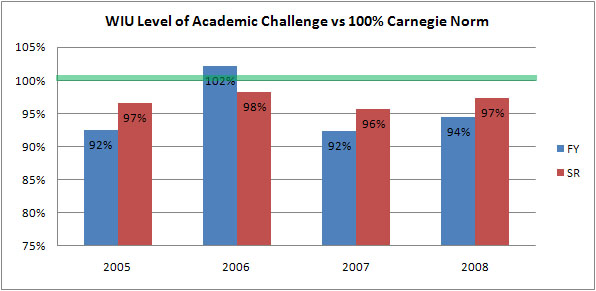
Active and Collaborative Learning
Spring 2008 saw an unexpected decline in Western's progress in increasing its Active & Collaborative Learning. Following a peek in Spring 2006, freshmen decreased markedly in Spring 2007 and were not quite able to stem the decline in Spring 2008. However, freshmen are still above the initial Spring 2005 levels. While seniors maintained their peek for a second year in Spring 2007, they fell to initial Spring 2005 levels in Spring 2008. A goal for the Spring 2009 NSSE is to reverse these negative trends and move Western forward in meeting the national mean for all Carnegie Master's level institutions, Western's comparative benchmark.
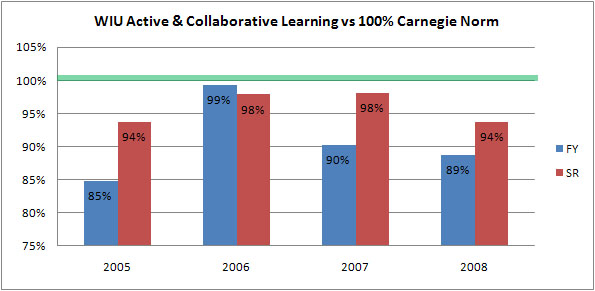
Student-Faculty Interaction
Spring 2008 saw both Western's freshmen and seniors meet the national mean for all Carnegie Master's level institutions in terms of Student-Faculty Interaction. However, Western has much loftier goals and views Student-Faculty Interaction as a critical component in its Higher Values in Higher Education strategic plan. Spring 2006 results set Western's own goal of excellence, with the new First Year Experience program driving freshmen levels 119% of the national average, a top-10% mark, and senior levels also well above the national average at 107%. Following the Spring 2006 peak, results fell of markedly for freshmen in Spring 2007, and have begun to rebound in Spring 2008. Unexpectedly, senior levels of student-faculty interaction declined to the national norm in Spring 2008, following two consecutive years of excellence. A goal for the Spring 2009 NSSE is to make progress in returning to the peak levels of Student-Faculty interaction that Western achieved in Spring 2006.
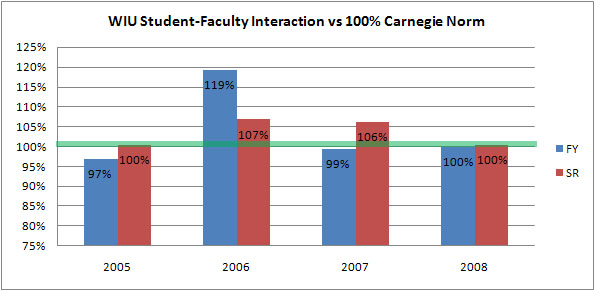
Enriching Educational Experience
Spring 2008 saw Western continue to struggle which meeting its goals in providing students with an Enriching Educational Experience, despite ongoing initiatives to address this concern. Likely supported by Western's new First Year Experience program, Spring 2006 levels rose markedly for freshmen and also saw a peak for seniors. However, since then, levels have continually fallen, although they still surpass initial Spring 2005 results. A goal for the Spring 2009 NSSE is to reverse these negative trends and move Western forward in meeting the national mean for all Carnegie Master's level institutions, Western's comparative benchmark.
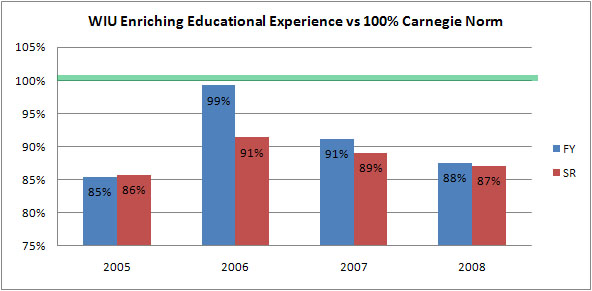
Supportive Campus Environment
Spring 2008 saw both Western's freshmen and seniors surpass the national mean for all Carnegie Master's level institutions in terms of Supportive Campus Environment. However, as with Student-Faculty Interaction, Western has much loftier goals in providing a Supportive Campus Environment. Spring 2006 results set Western's own goal of excellence, with both freshmen and seniors scoring at 106% of the national benchmark. The decline seen for freshmen in Spring 2007 has been successfully reversed in Spring 2008, achieving a 102% mark. However, while seniors continue to be above the national mean, they saw an unexpected decline to 101% in Spring 2008. A goal for the Spring 2009 NSSE is to reverse the senior decline and to continue the positive freshmen progress, ensuring that Western well exceed the national average in Supportive Campus Environment.
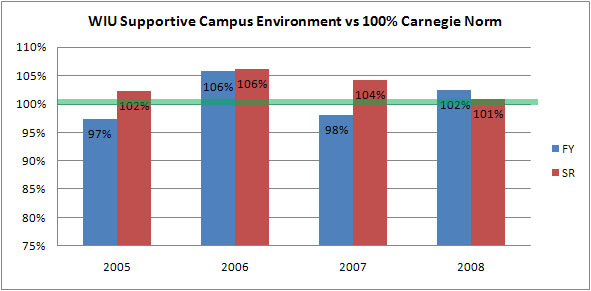
In-Depth Analysis
A more in-depth analysis providing the individual components that comprise each of the 5 NSSE benchmarks of effective educational practices is provided below in PDF format.

Connect with us: